Olga Murray: Tribute Gallery
Listen to some of Olga’s favorite Nepali music as you scroll through this tribute gallery.

As our NYF team began the solemn work of planning the first Founder’s Day following Olga’s passing, we were struck again and again by the incredible scope of her 98 years of life.
How could we memorialize such a woman, doing justice to her memory while continuing her beloved organization’s steady forward momentum?
What follows is our humble attempt to honor and celebrate Olga’s remarkable lifetime and her captivating, loving, optimistic spirit.
At our Founder’s Day event, the items below we arranged around the perimeter of a large room, where visitors were encouraged to reflect on Olga’s life, on the experiences that would later become the Nepal Youth Foundation, and on her wishes for the future.
We are honored to welcome you to our digital recreation of this space.
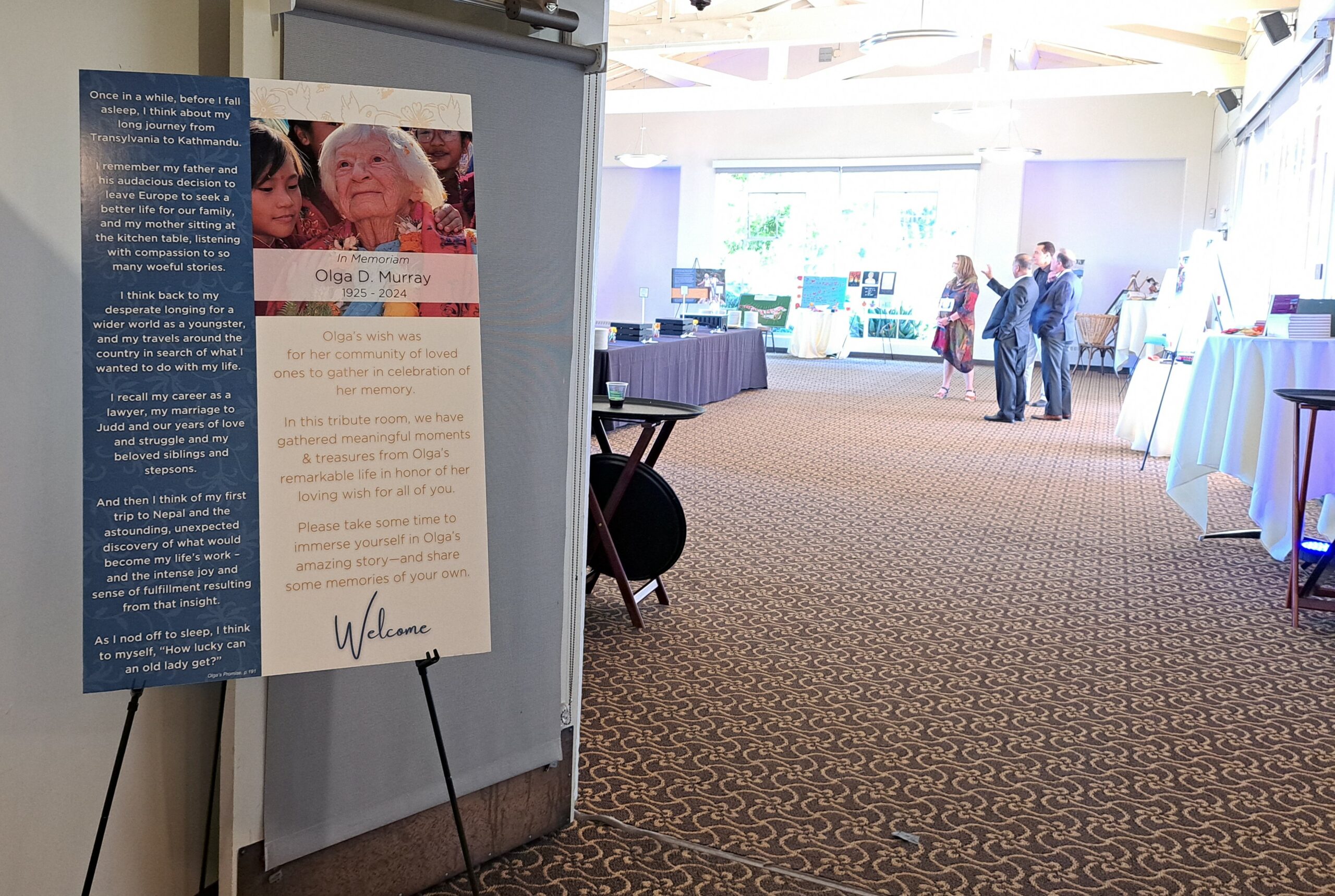
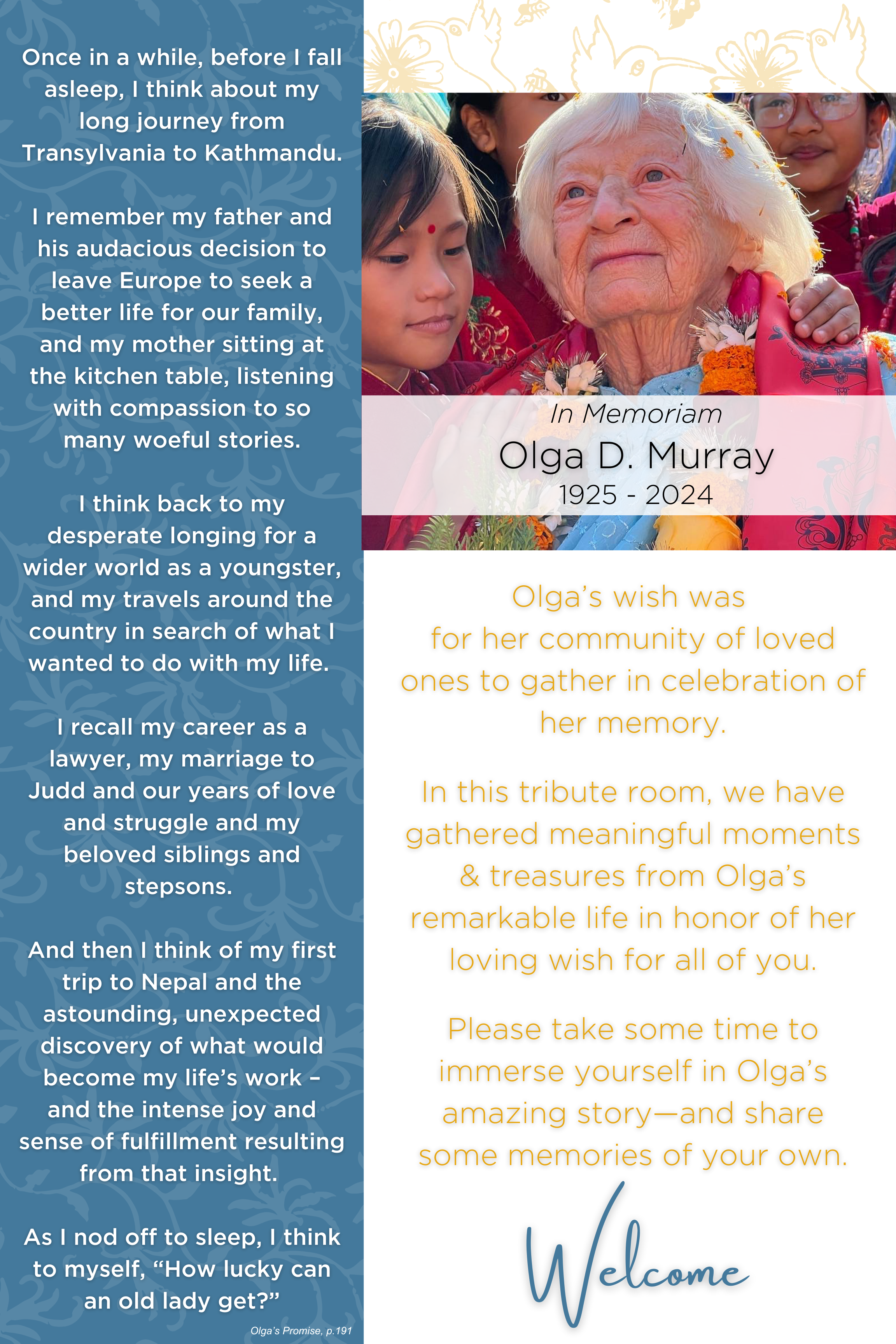
⮟
Wisdom from Olga’s Loving Parents
Olga’s parents left behind a remarkable legacy of their own through their daughter.
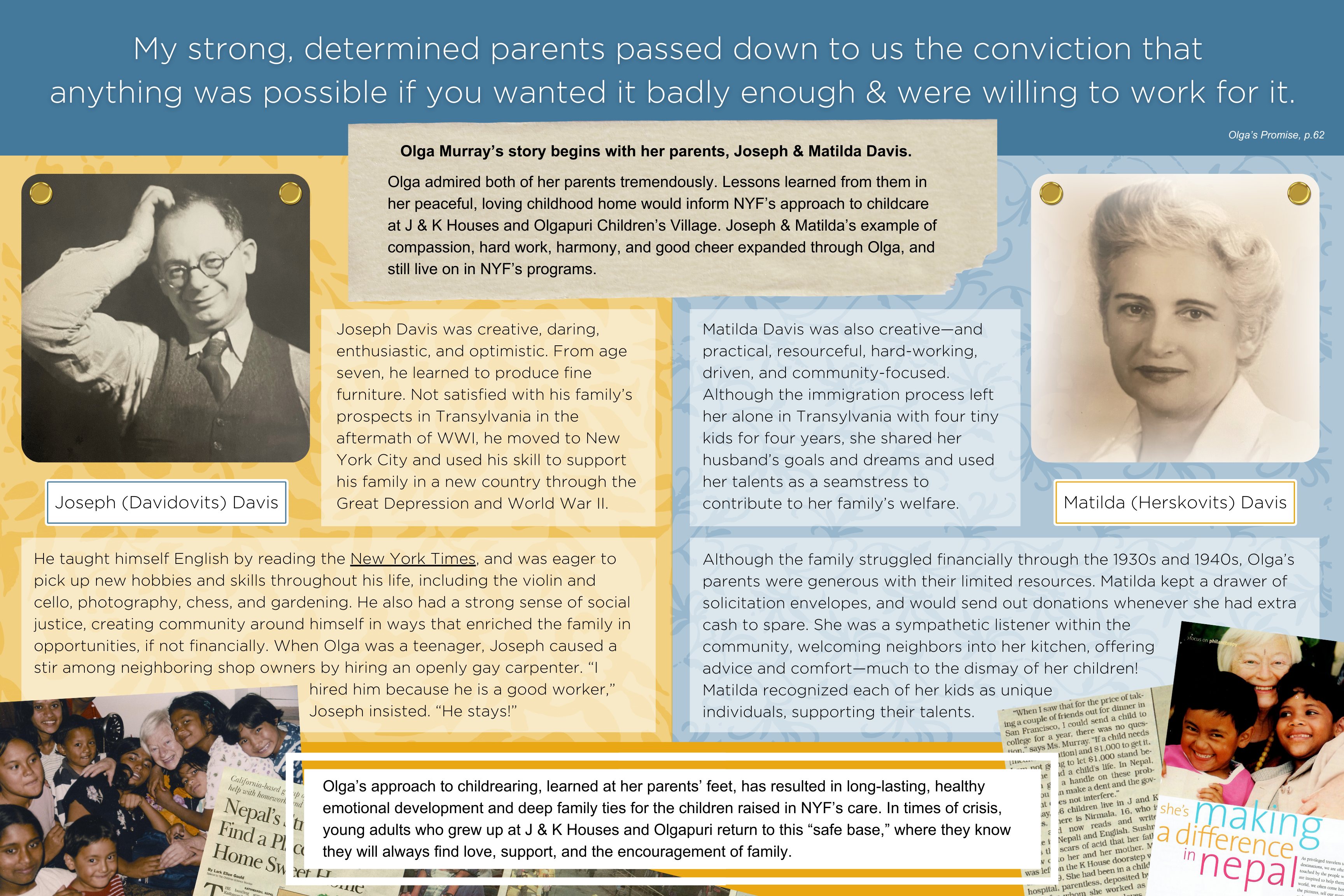
⮟
Growing Up in Troubled Times
During her early years, Olga’s life intersected with times of tremendous social change. Lessons learned during these historic moments formed the foundation of her daring can-do attitude towards daunting social challenges in Nepal.
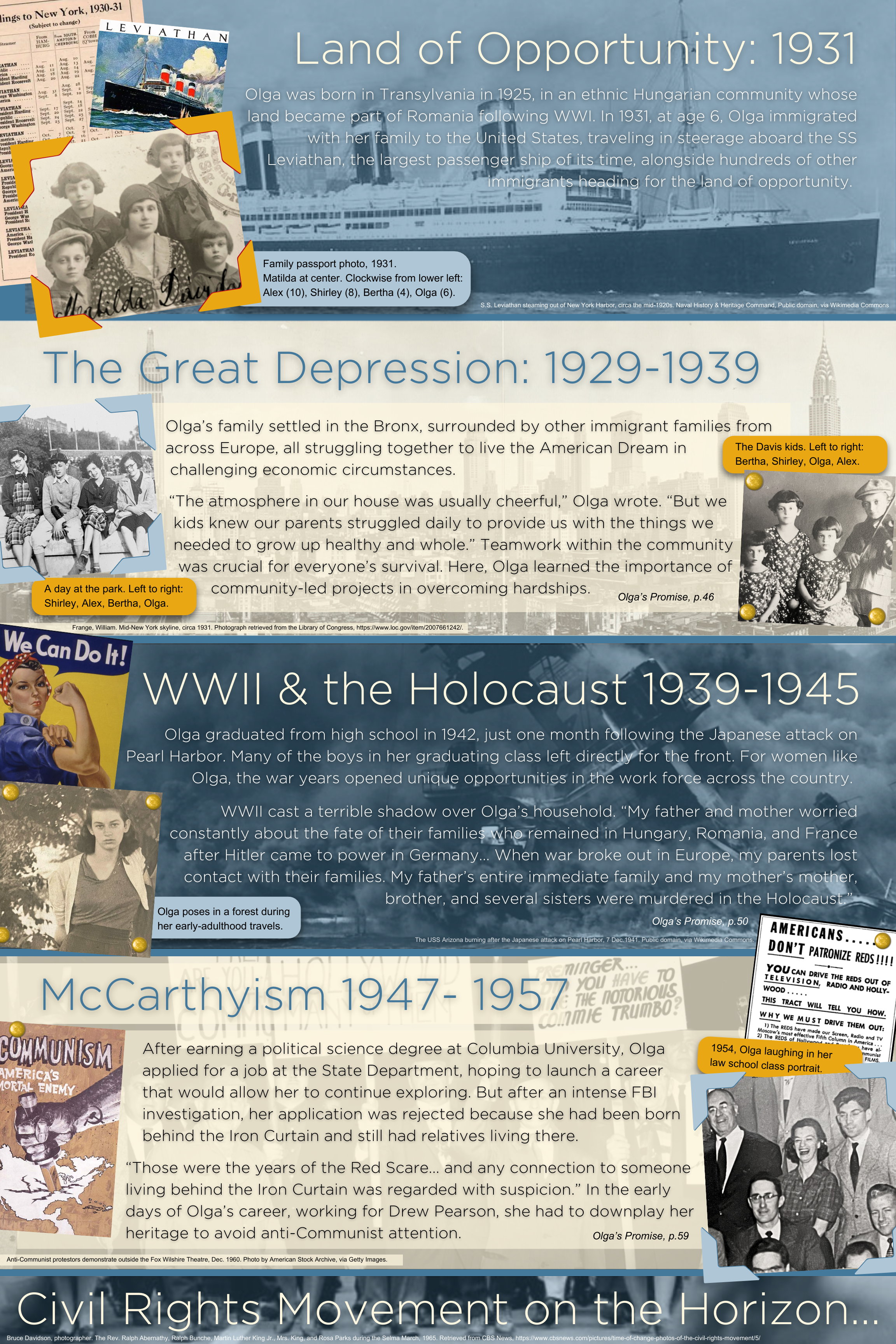
⮟
Spirit of Adventure
Olga was born eager to experience the world. At only 17, she set off on a cross-country American adventure that cemented her confidence in her own abilities.
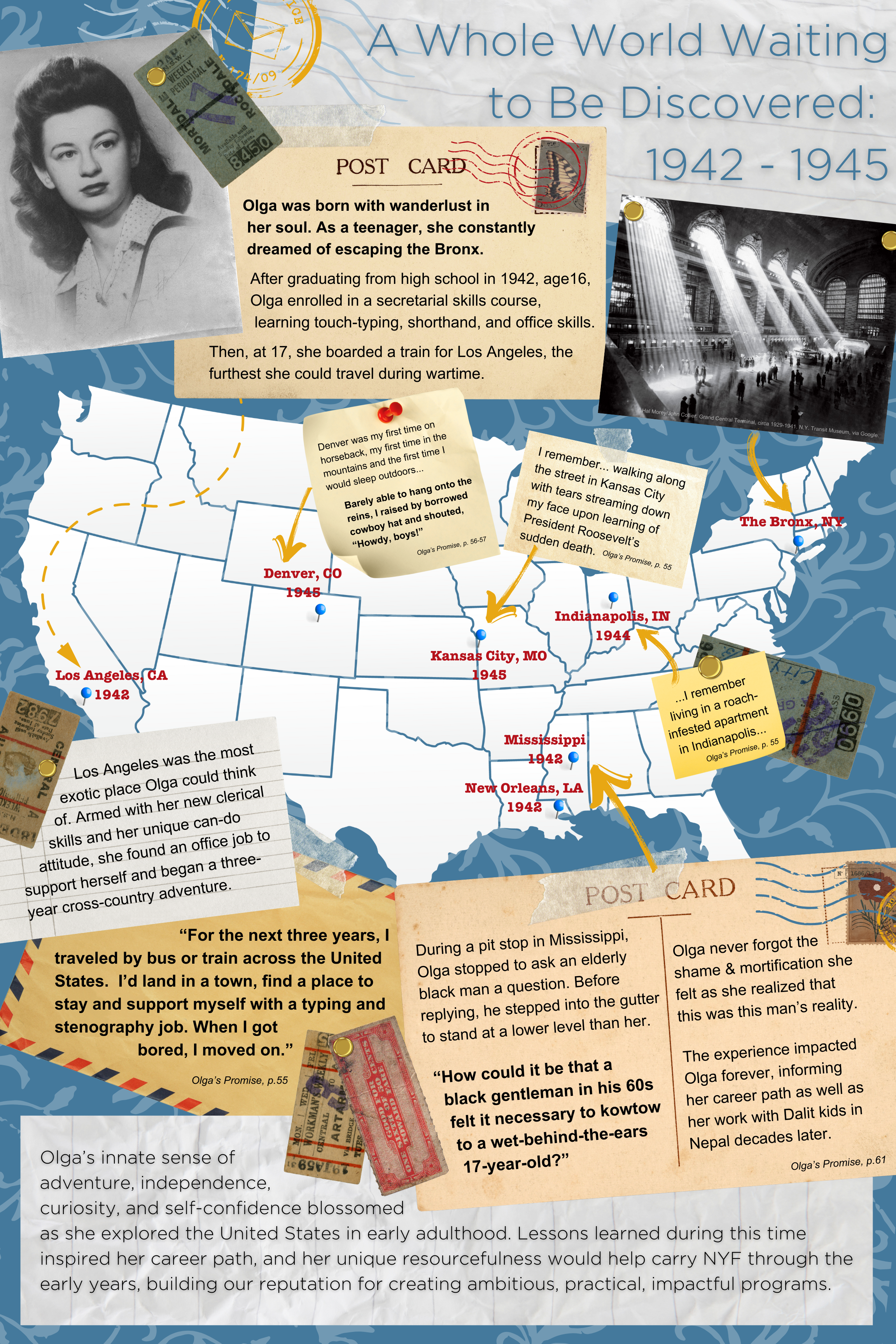
Olga’s family was generous enough to lend us some cherished mementos for display in the Tribute Room. This display, set up beside the story of Olga’s American adventure, includes her American Youth Hostels pass from 1952 (during her college years), a United States passport from her early adult years (used to travel to Europe in the 1950s), her New York Central Railroad pass for June 1946, and her New York Public Library card from the late 1940s.
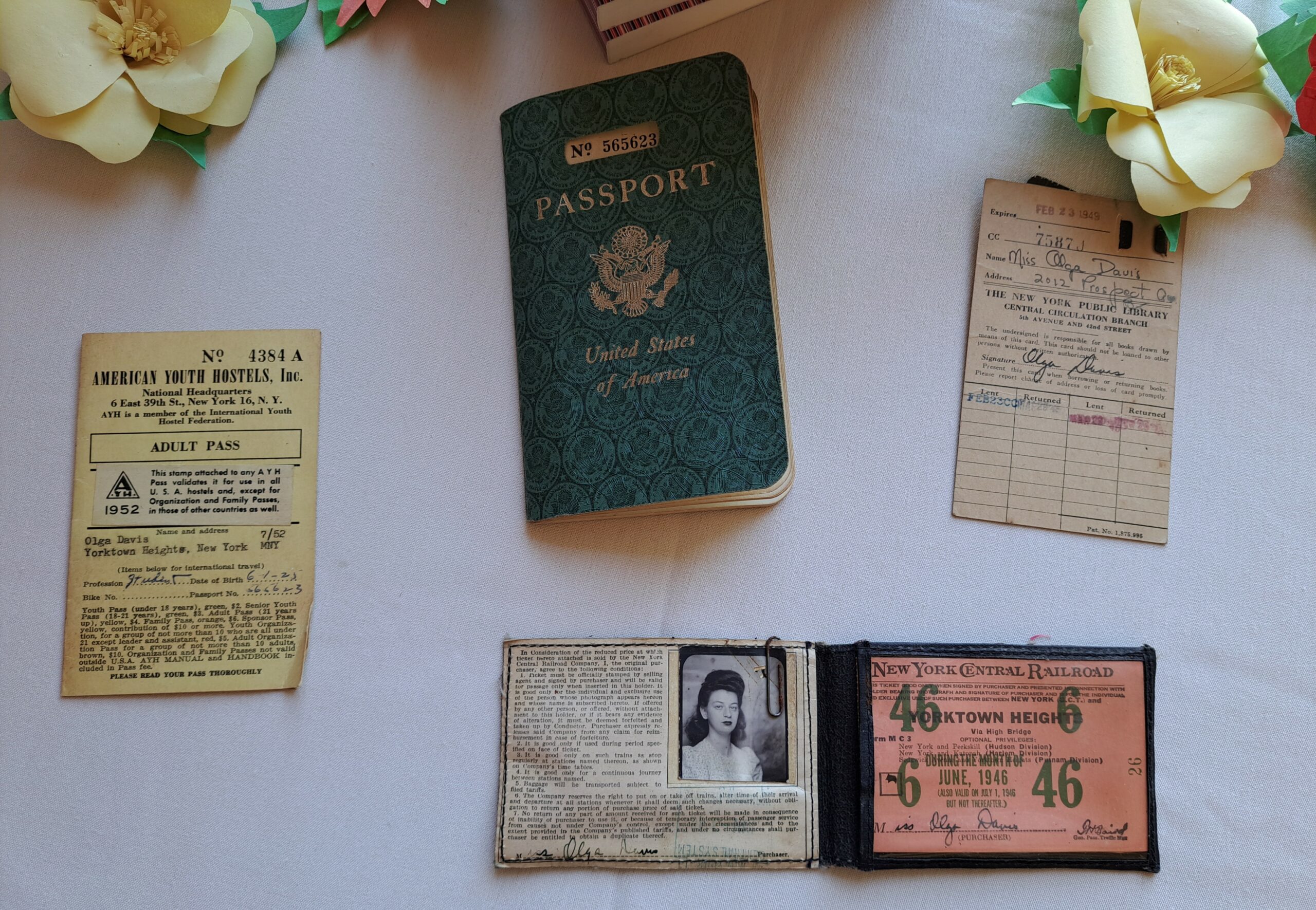
⮟
Education and Belief from Mentors
Olga’s educational ambition was remarkable for a young woman of her time—and she benefited tremendously from the impact of others who believed in her abilities.
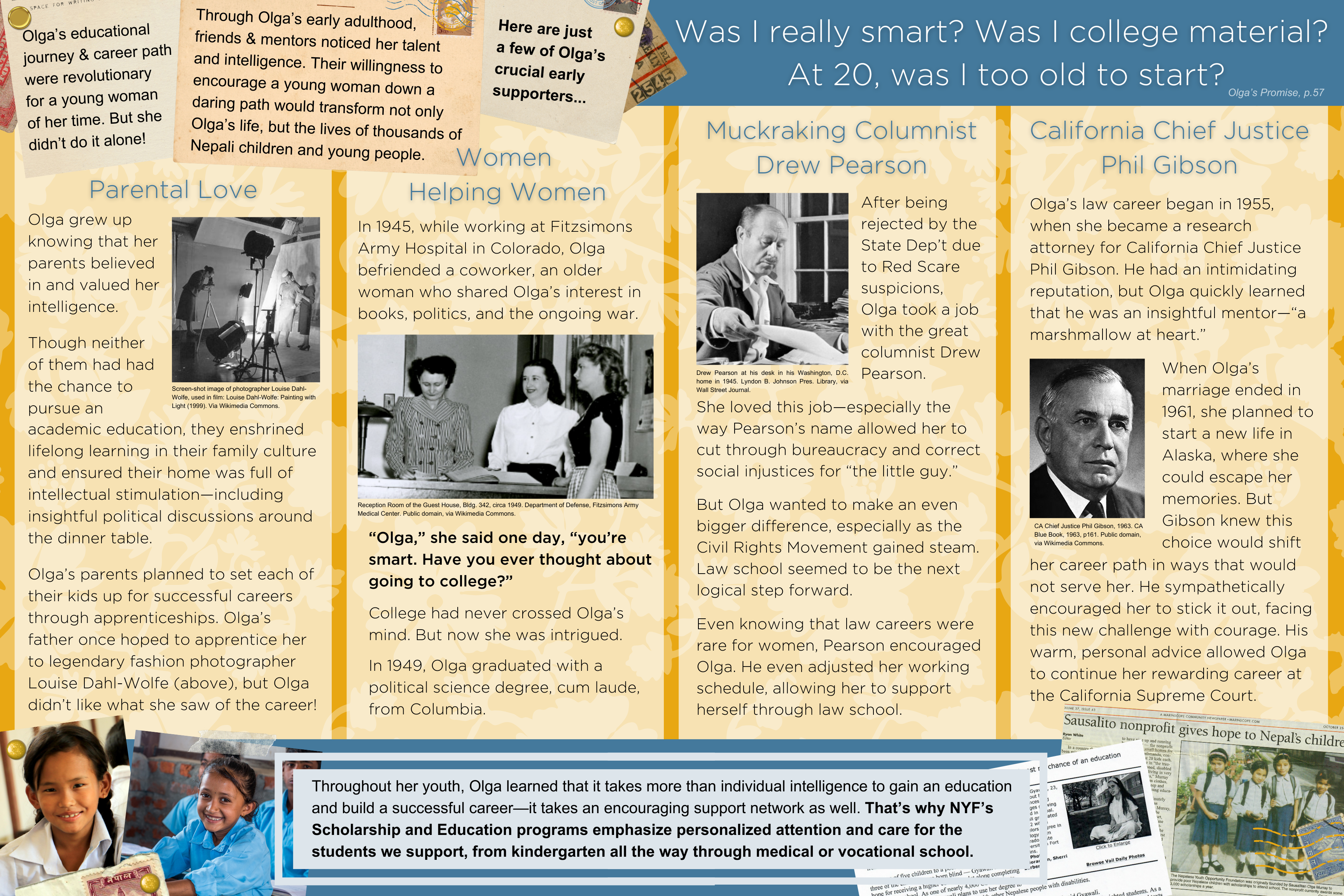
⮟
A Woman Lawyer
Olga became a lawyer before American women had won many of the rights they enjoy today. During her career, she witnessed amazing strides in women’s rights. This journey would later directly inform the Empowering Freed Kamlaris program in western Nepal.
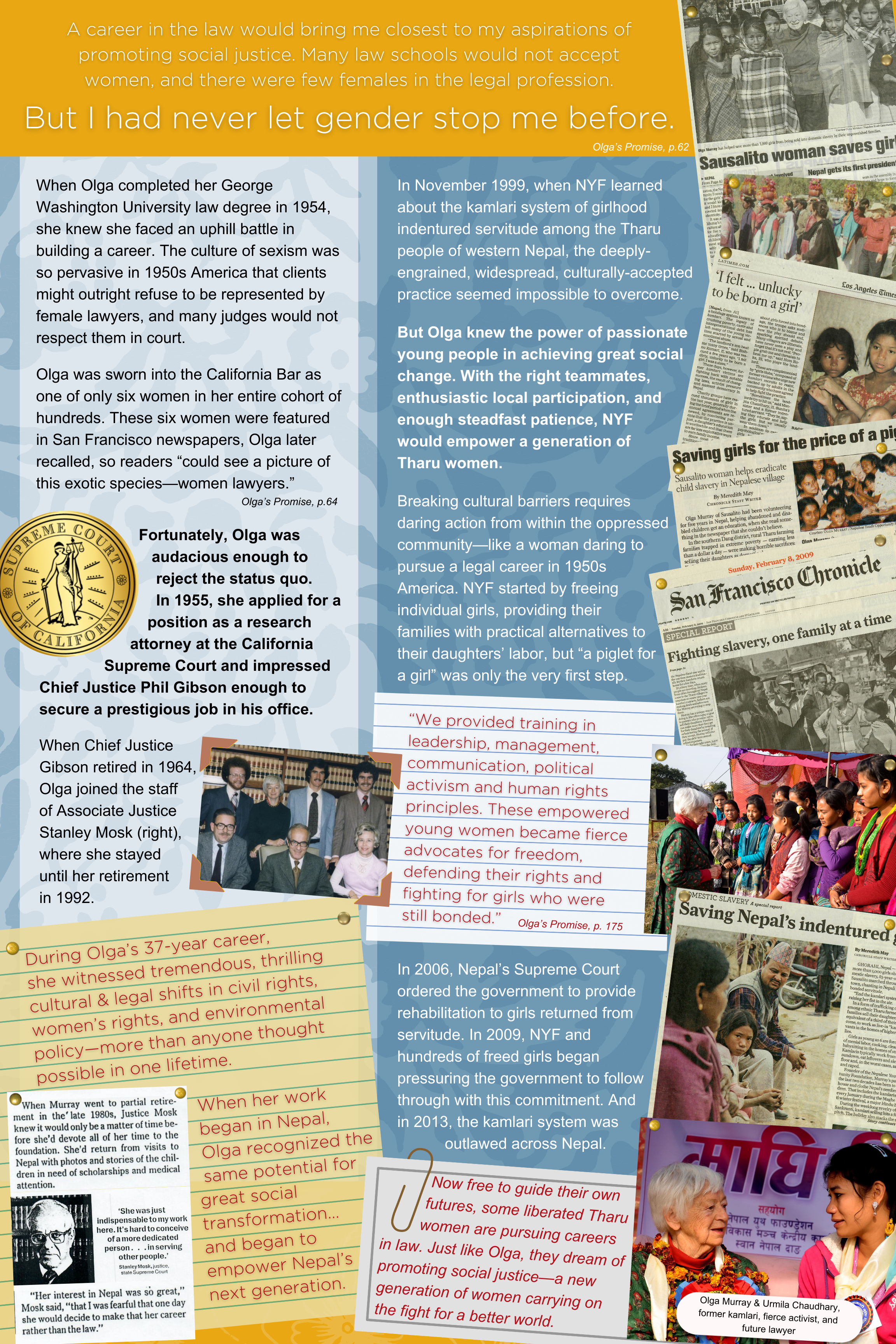
⮟
Family Life
Though Olga’s family life took a nontraditional route, she built loving family relationships wherever she went, playing many cherished roles in the lives of thousands. We could not tell the story of Olga’s life without including her husband and friend, Judd Murray, and her stepsons, Pat and Steve.
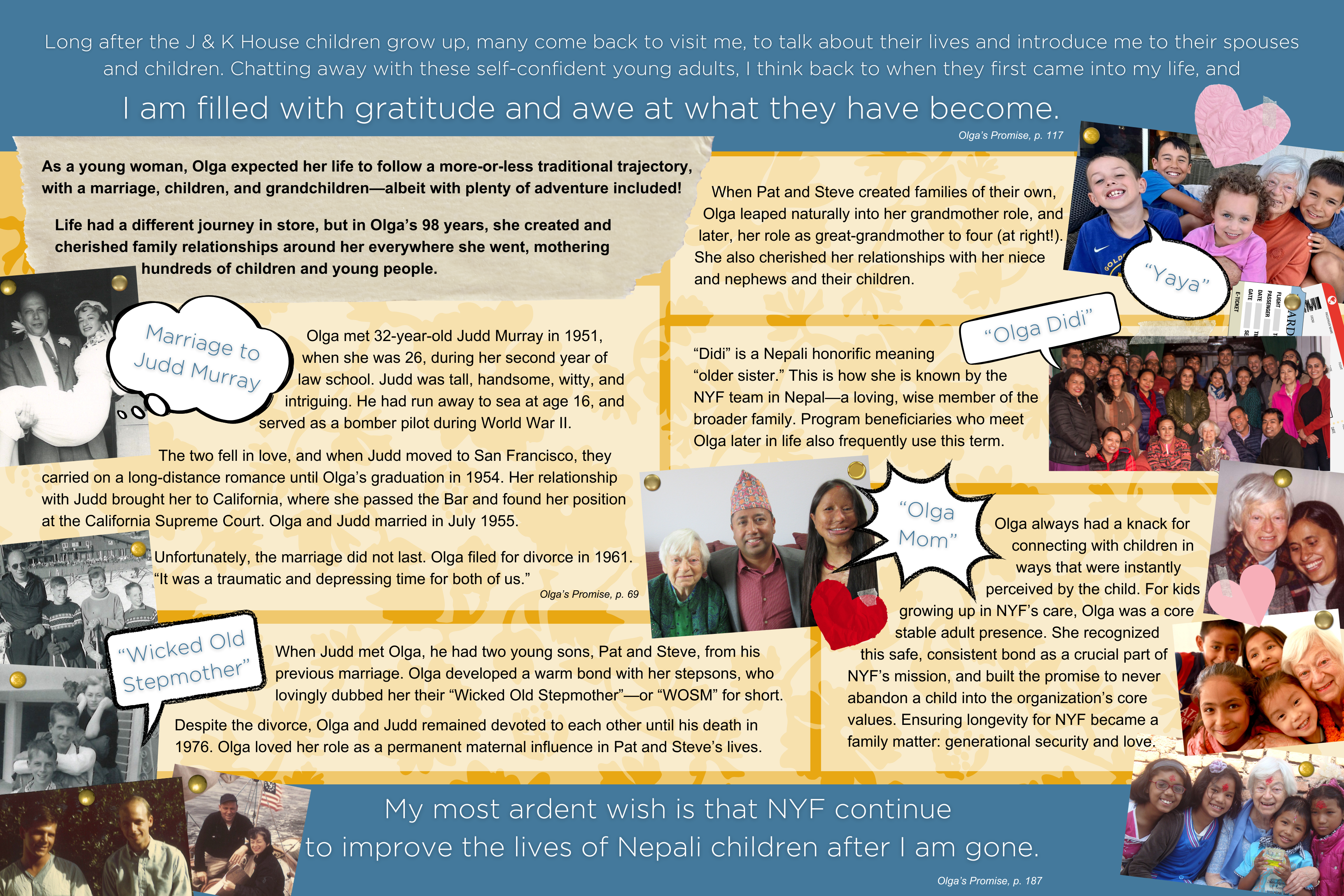
⮟
The Nepal team members who visited the United States for Founder’s Day brought messages and artwork with them from the Olgapuri children, ensuring as much family representation as possible. These art pieces were arranged on a poster to be displayed next to Olga’s family photos.
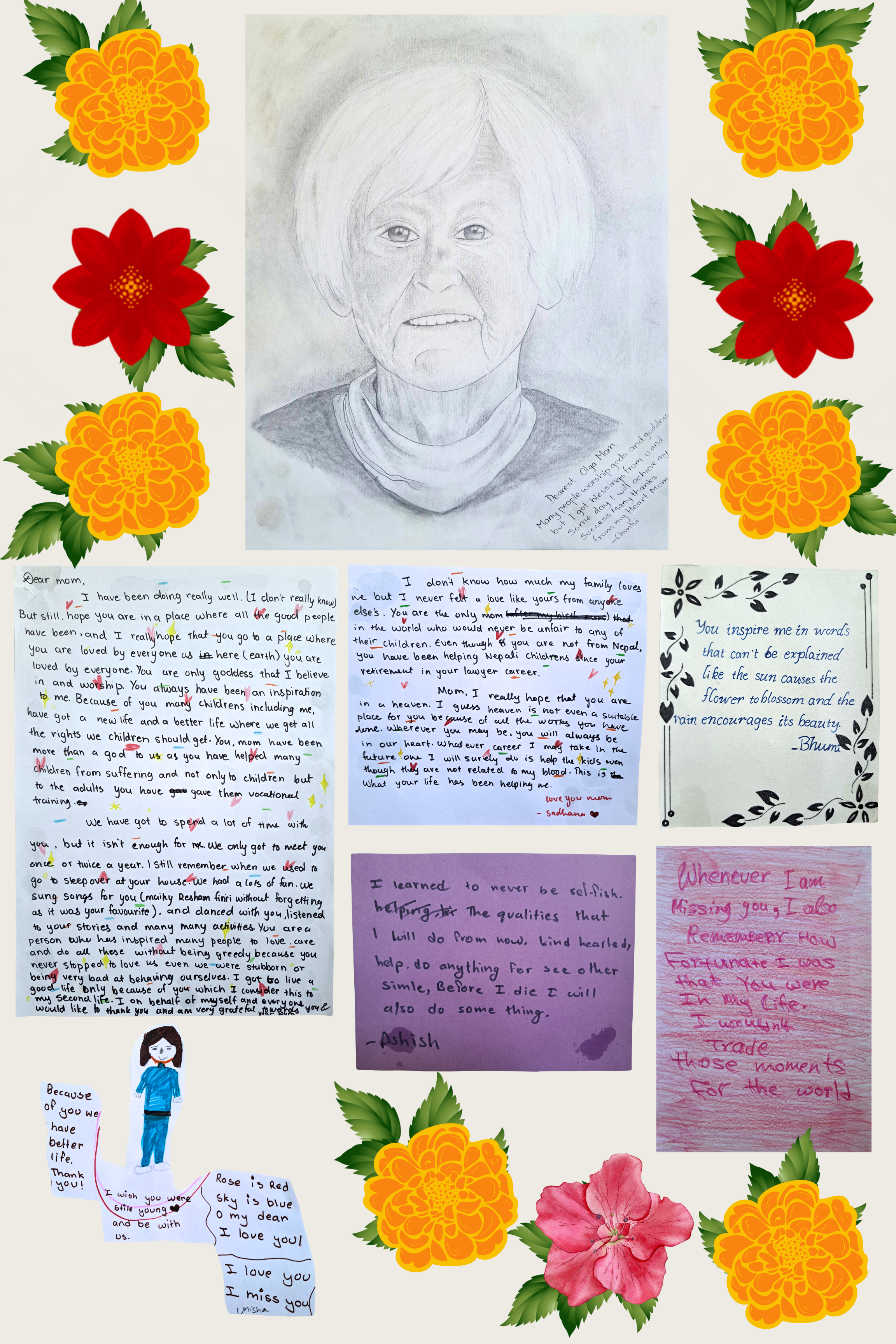
⮟
The Promise
No version of Olga’s life story would be complete without her remarkable promise to Nepal’s children, made in a sleeping bag one Himalayan night in 1984.
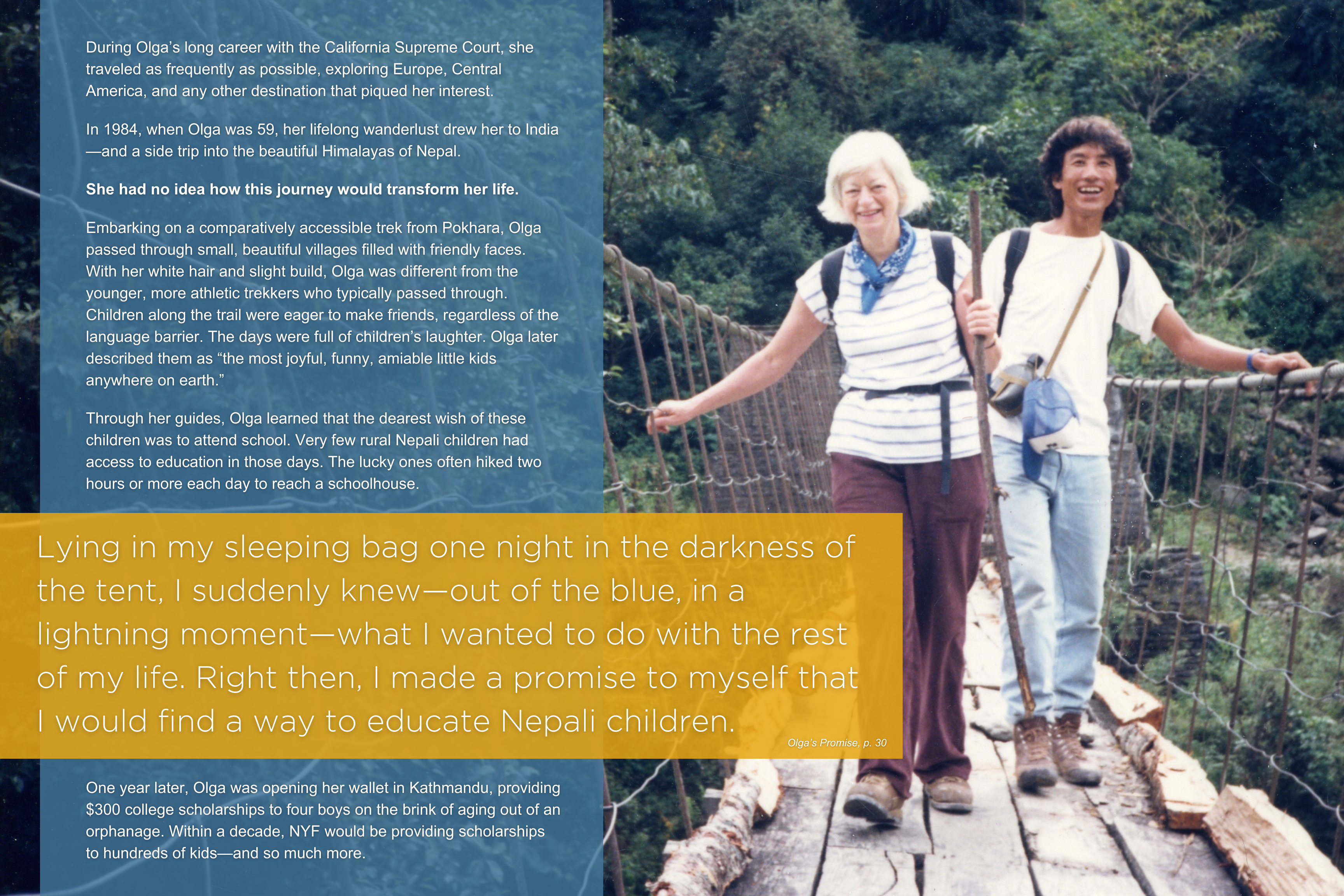
⮟
NYF’s Anjita Parajuli (in pink), visiting from Nepal, explains the genius of the Olgapuri Children’s Village campus to a Founder’s Day guest inside the Tribute Room.
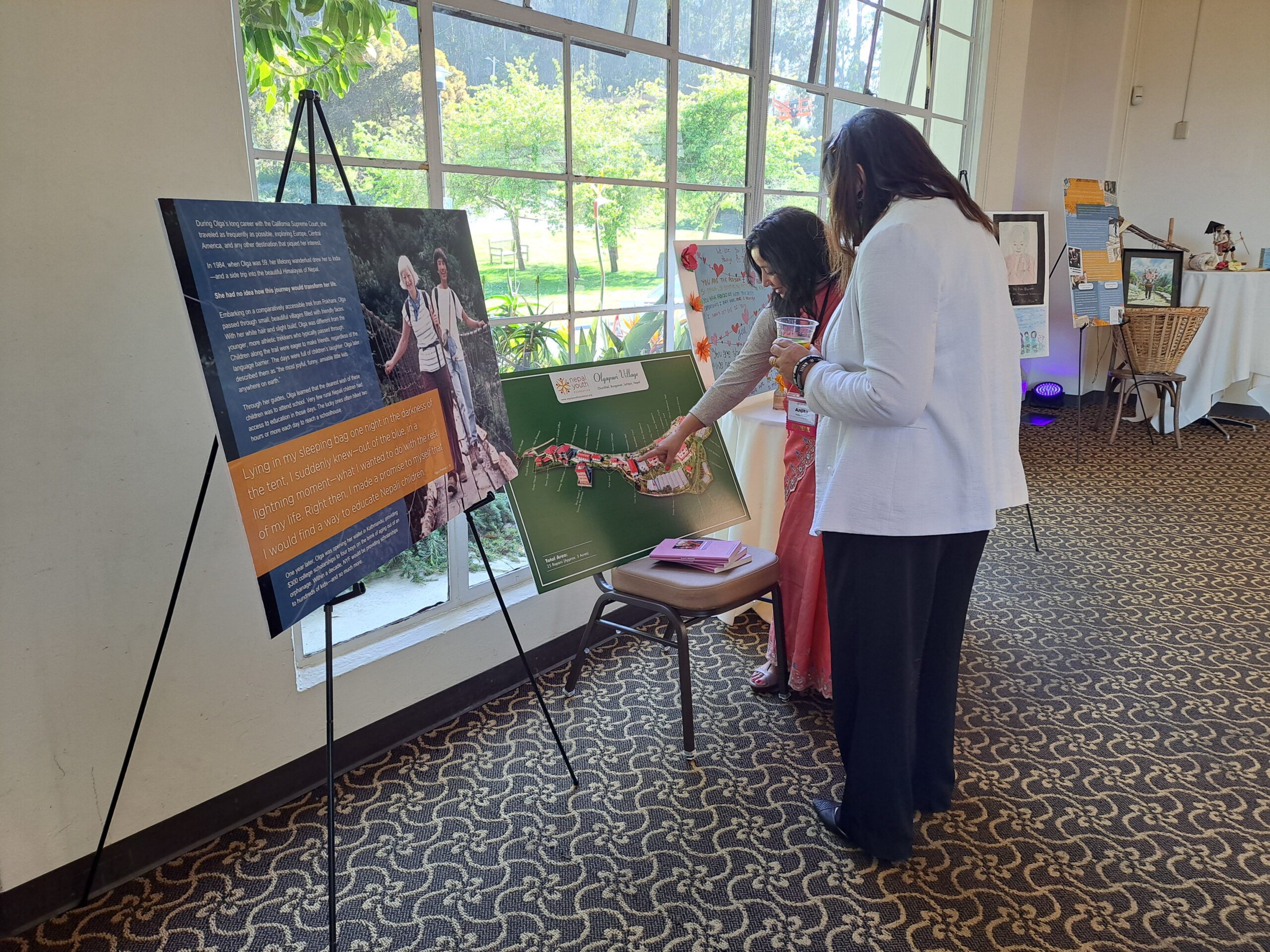
Map of Olgapuri Village
This detailed Olgapuri Children’s Village map was provided by the Nepal team. The enclosed campus houses up to 80 children at a time and includes farming space, greenhouses, and a cow barn to provide much of the nutritious food consumed here. Olgapuri Vocational School appears on the left.
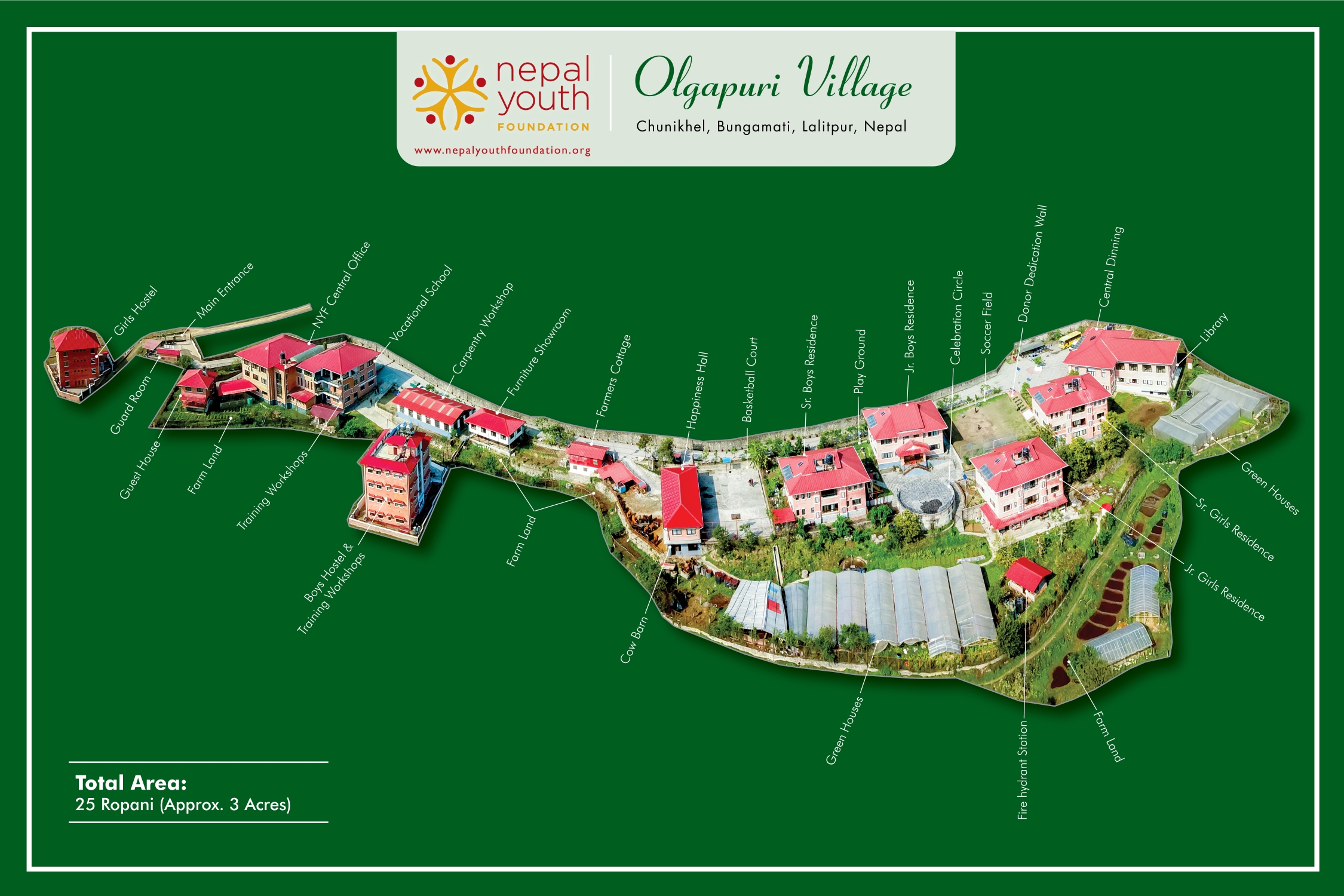
⮟
Artwork by the Olgapuri children was created during special activity sessions organized by Ankur Counseling Center to help the children process the loss of Olga. Each child decided whether they wanted to share their artwork with Founder’s Day guests and supporters like you. Knowing their artwork would be appearing at a memorial for Olga helped the children feel connected to efforts to honor her life.
We are amazed at the creativity of the Olgapuri children. Each poster of children’s artwork was embellished with handmade, three-dimensional construction paper flowers sent from Nepal. In these digital versions, we have approximated these flowers with images in similar colors.
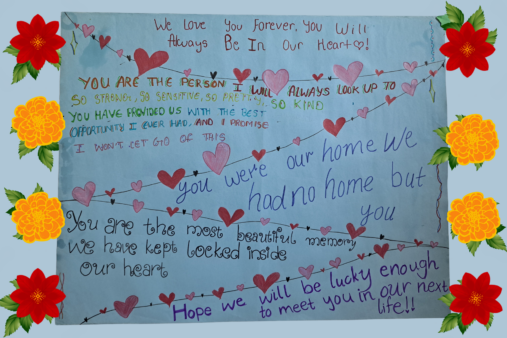
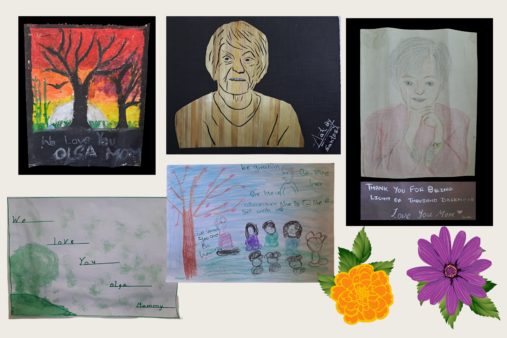
⮟
“Lucky Breaks” and Health Care
Olga’s adventures occasionally ended in injury—but she never let that stop her. In fact, she often used those moments to create her own good luck.
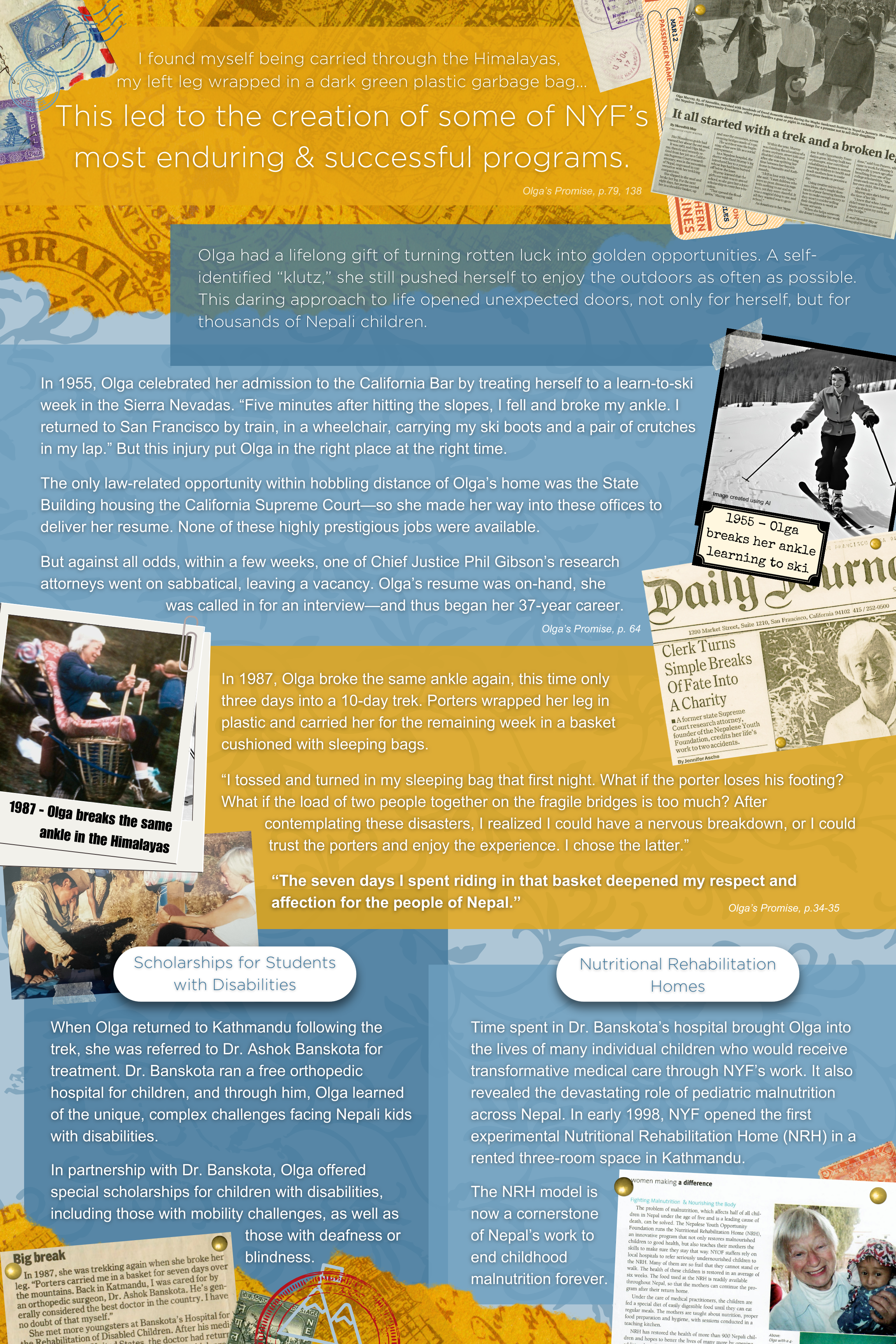
Olga herself found great humor in her occasionally disastrous adventuring luck. Her home was full of mementos commemorating her infamous Himalayan ankle break in 1987.
Olga’s family was generous enough to lend us the basket Olga was carried in when she broke her ankle on a trek, a beautiful watercolor painting of this incident, the actual cast she received upon her return to Kathmandu (kept safe in her closet for 36 years!), a playful statue of her porter carrying her, several trekking passes and travel documents from the 1980s, and a passport from his era.
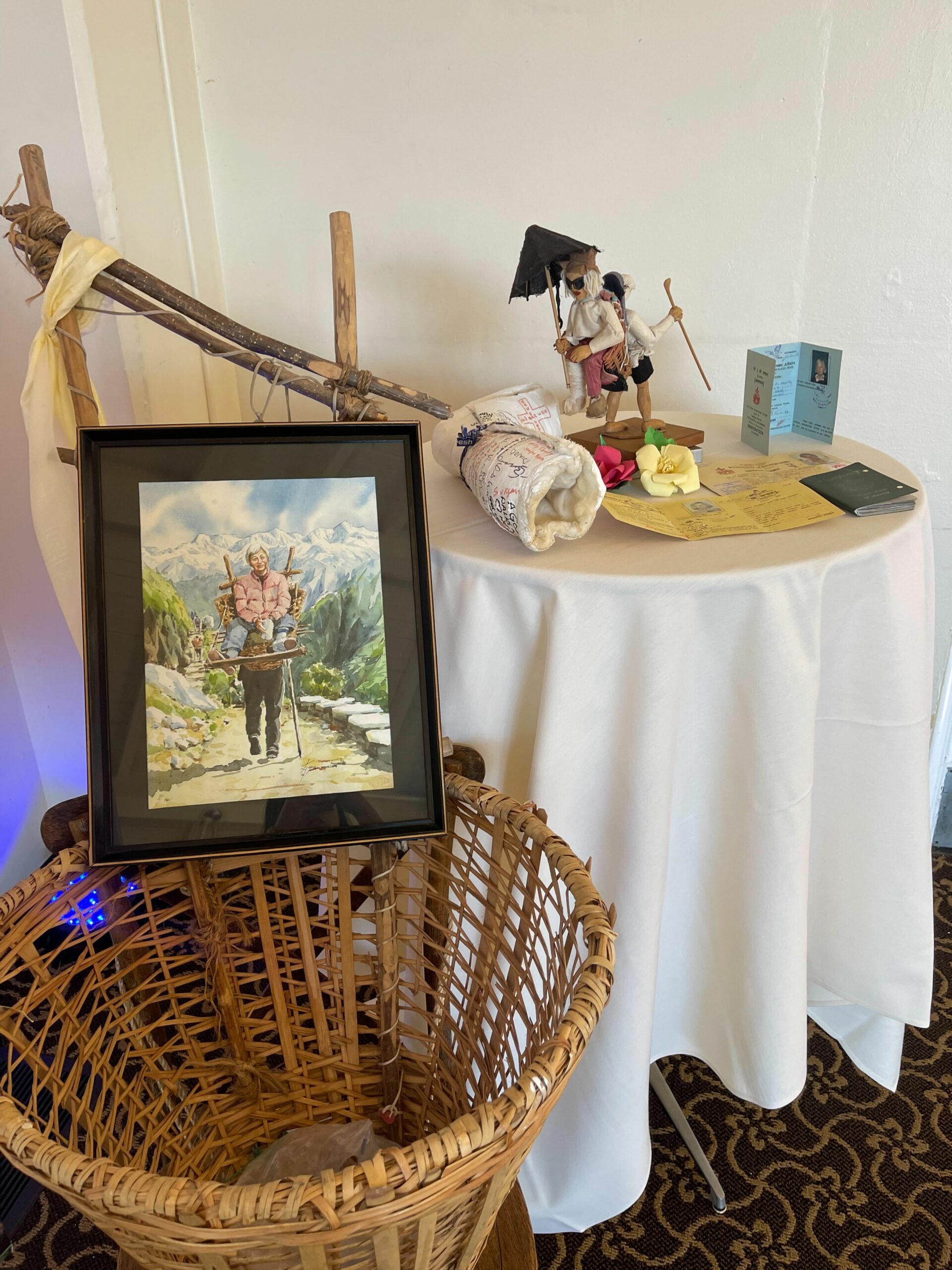
⮟
Community-led Service and Interventions
A key facet of Olga’s wisdom was in recognizing the importance of Nepali leadership and buy-in. NYF’s commitment to this principle is a major source of our success.
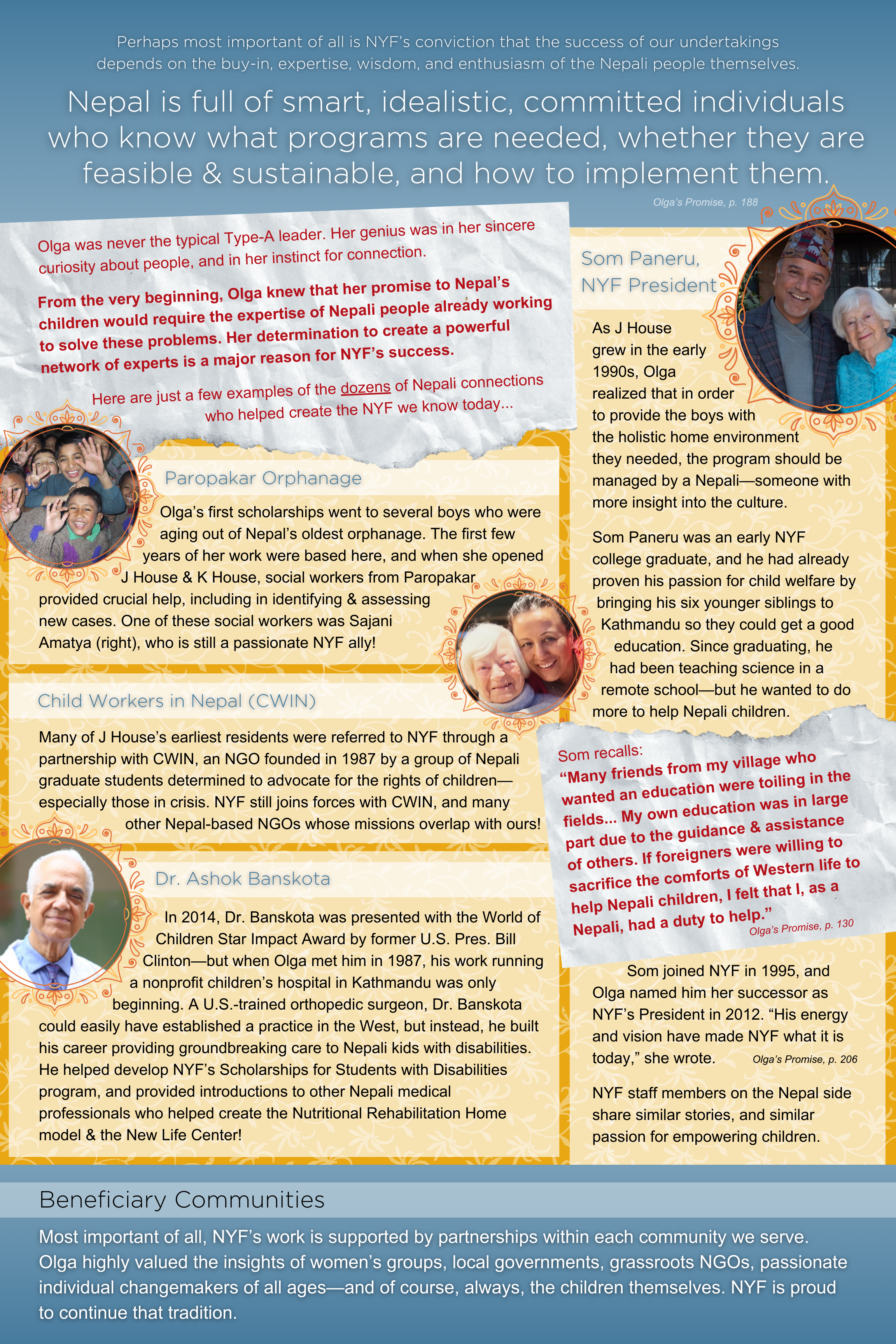
⮟
The next several images are loving messages in Olga’s memory, gathered from dear ones in Nepal including members of the NYF Nepal team, Freed Kamlari leaders, program alumni, and friends from other organizations. These messages were displayed beside the poster highlighting Nepali leadership.
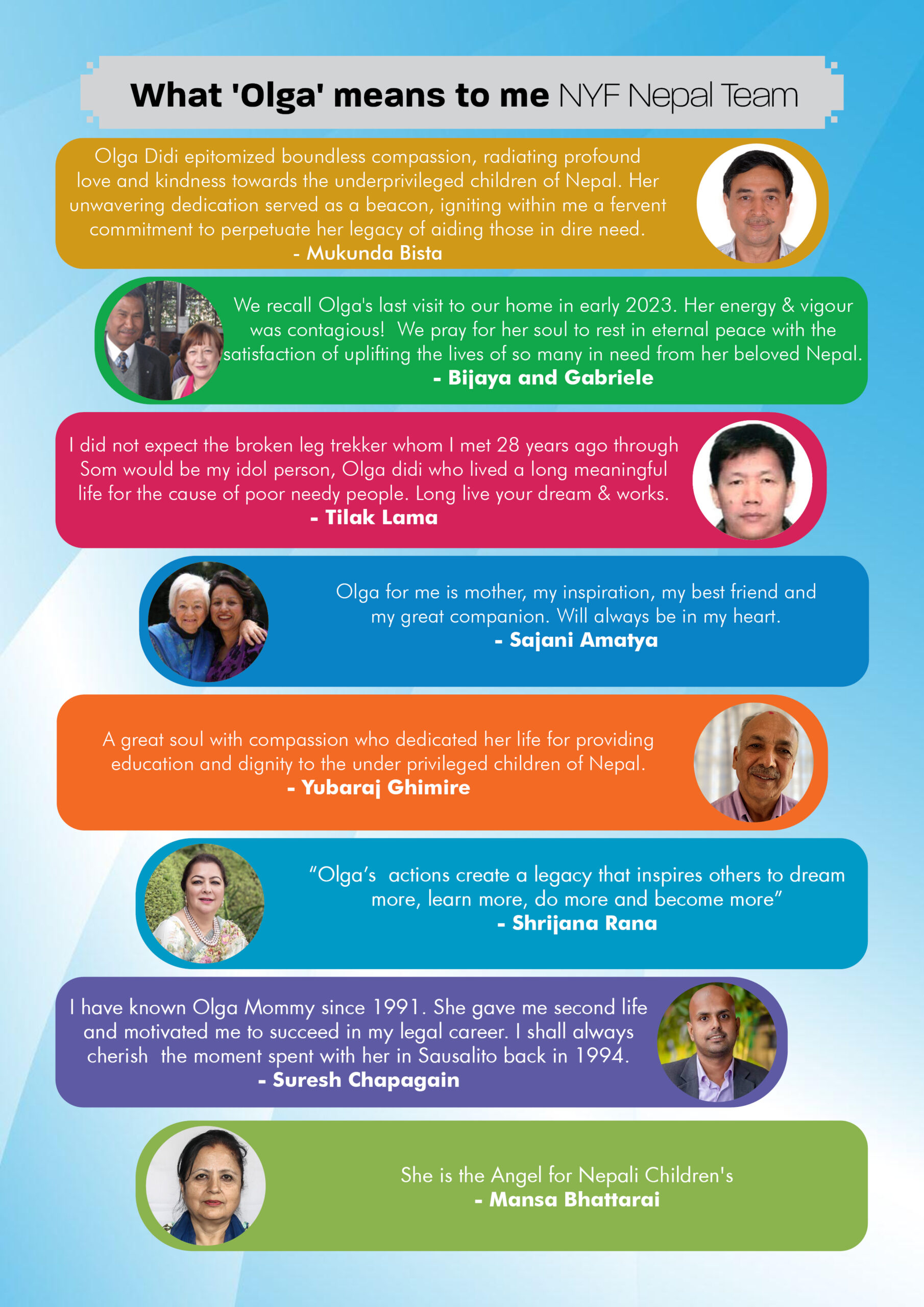
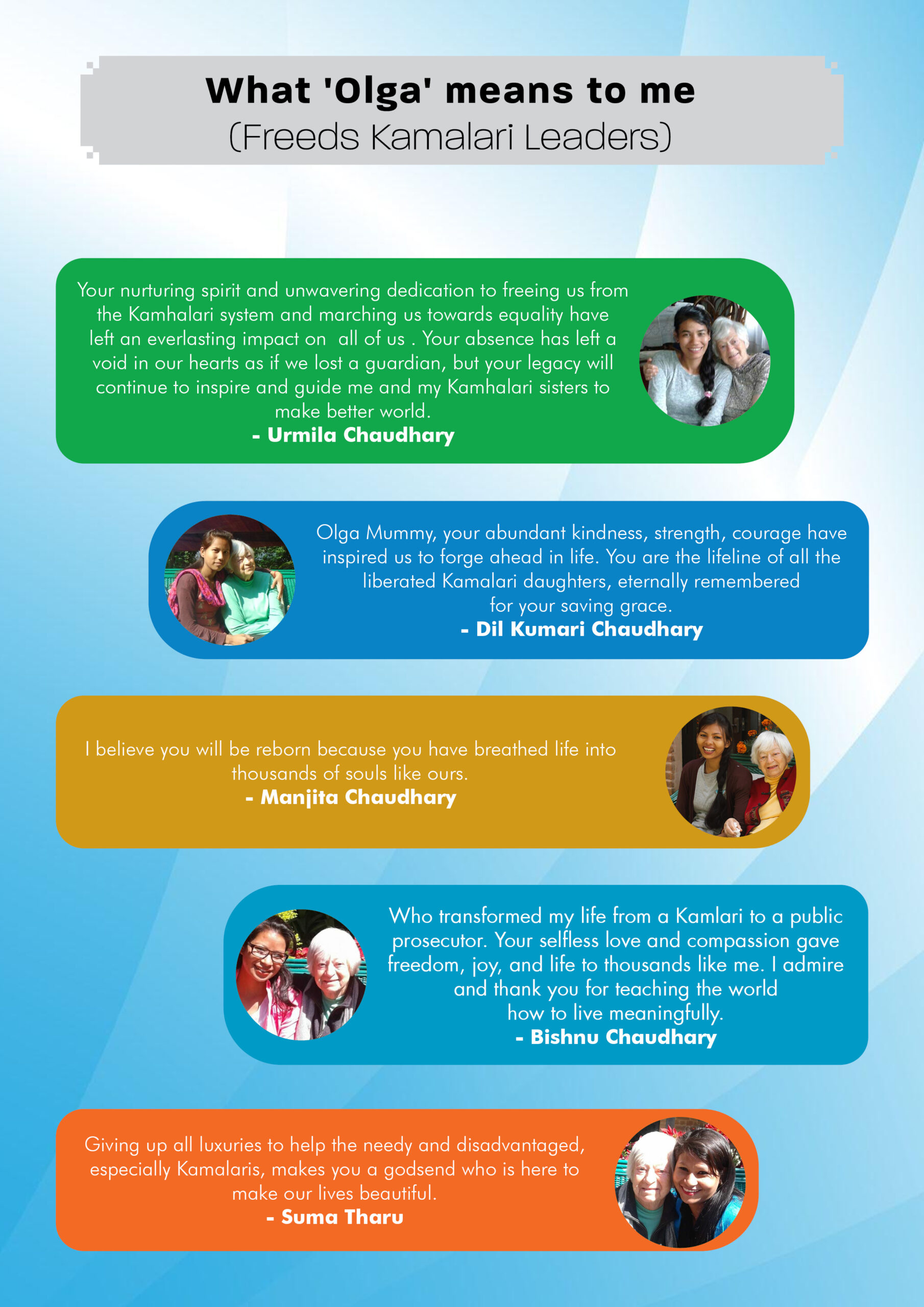
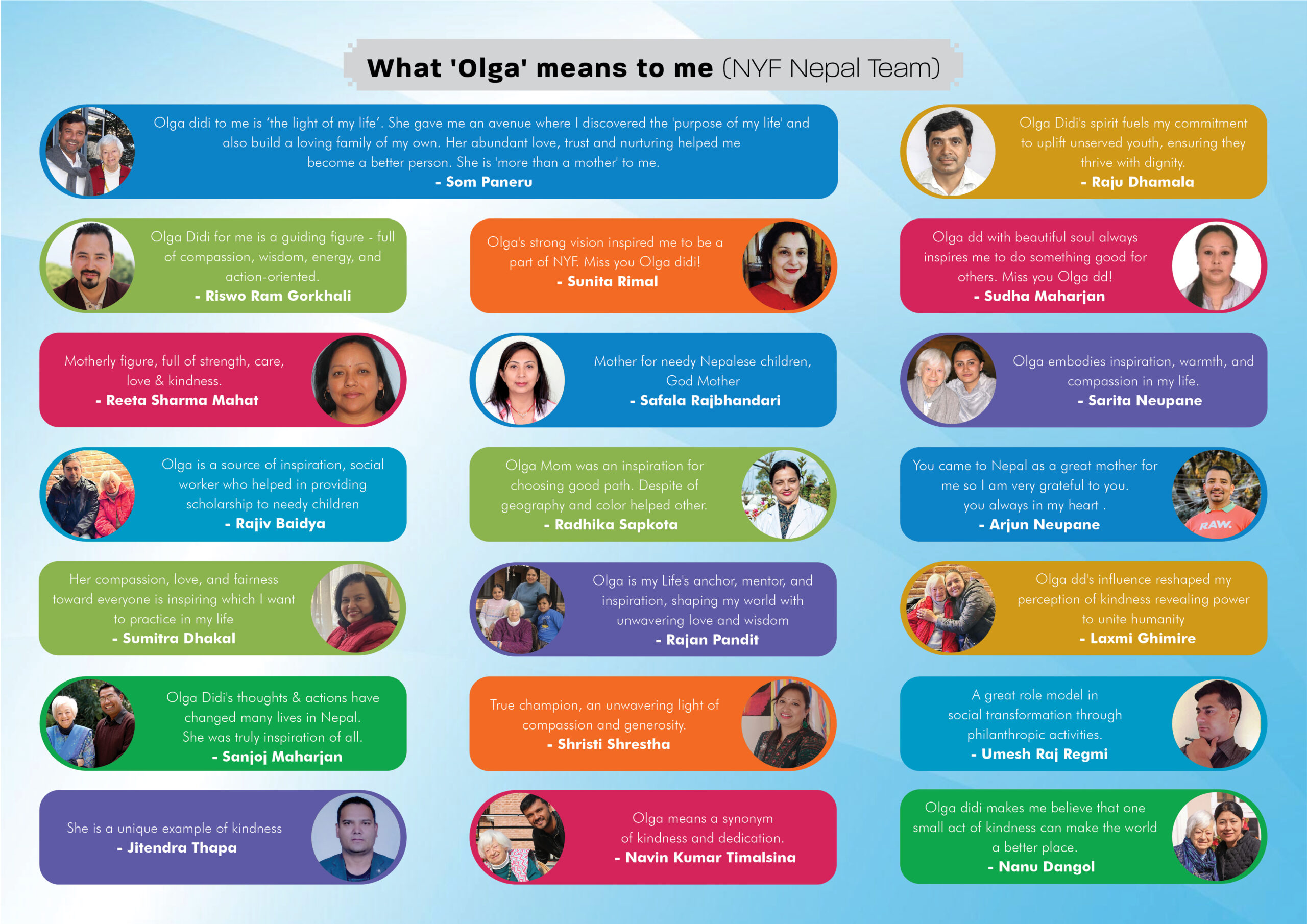
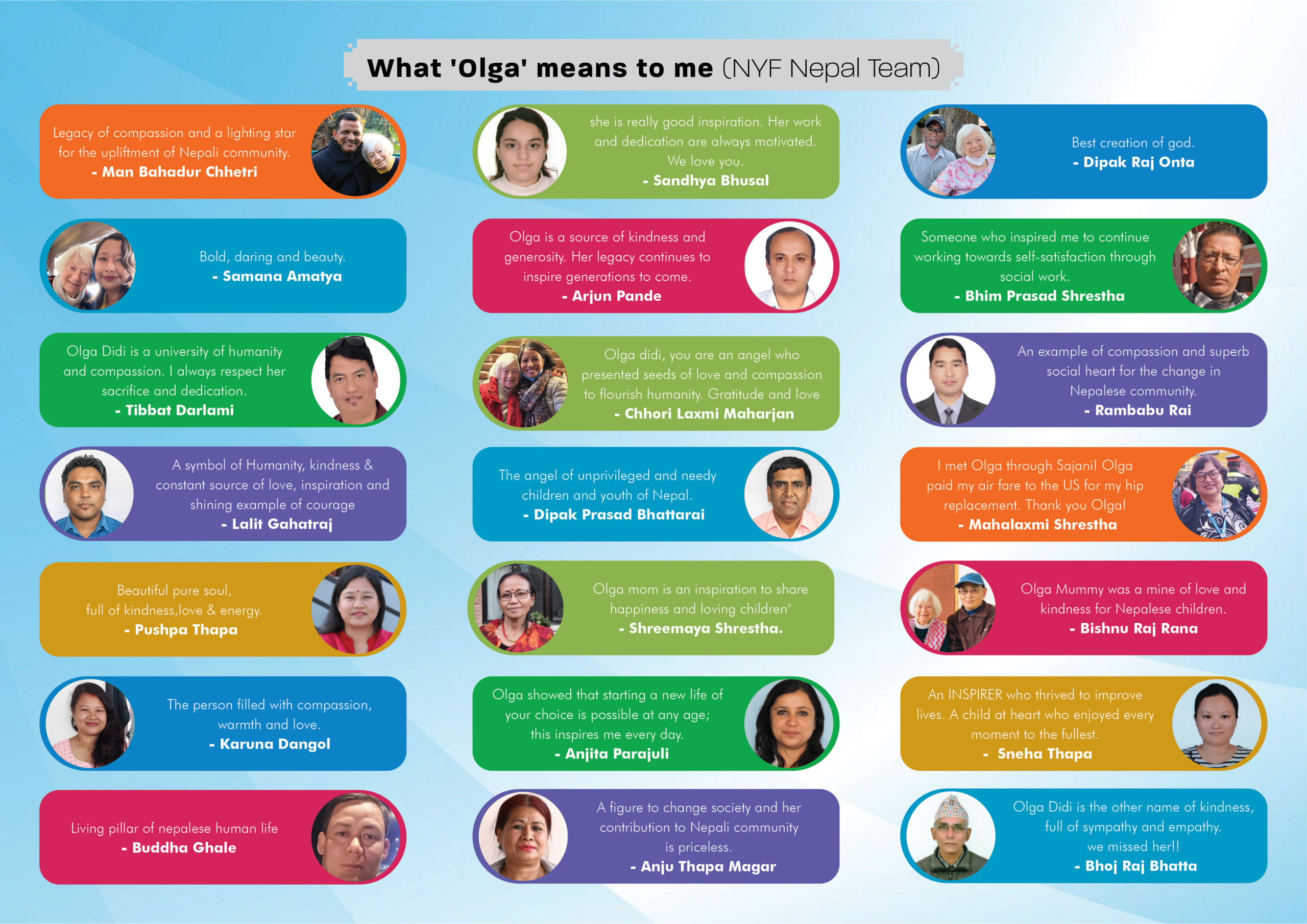
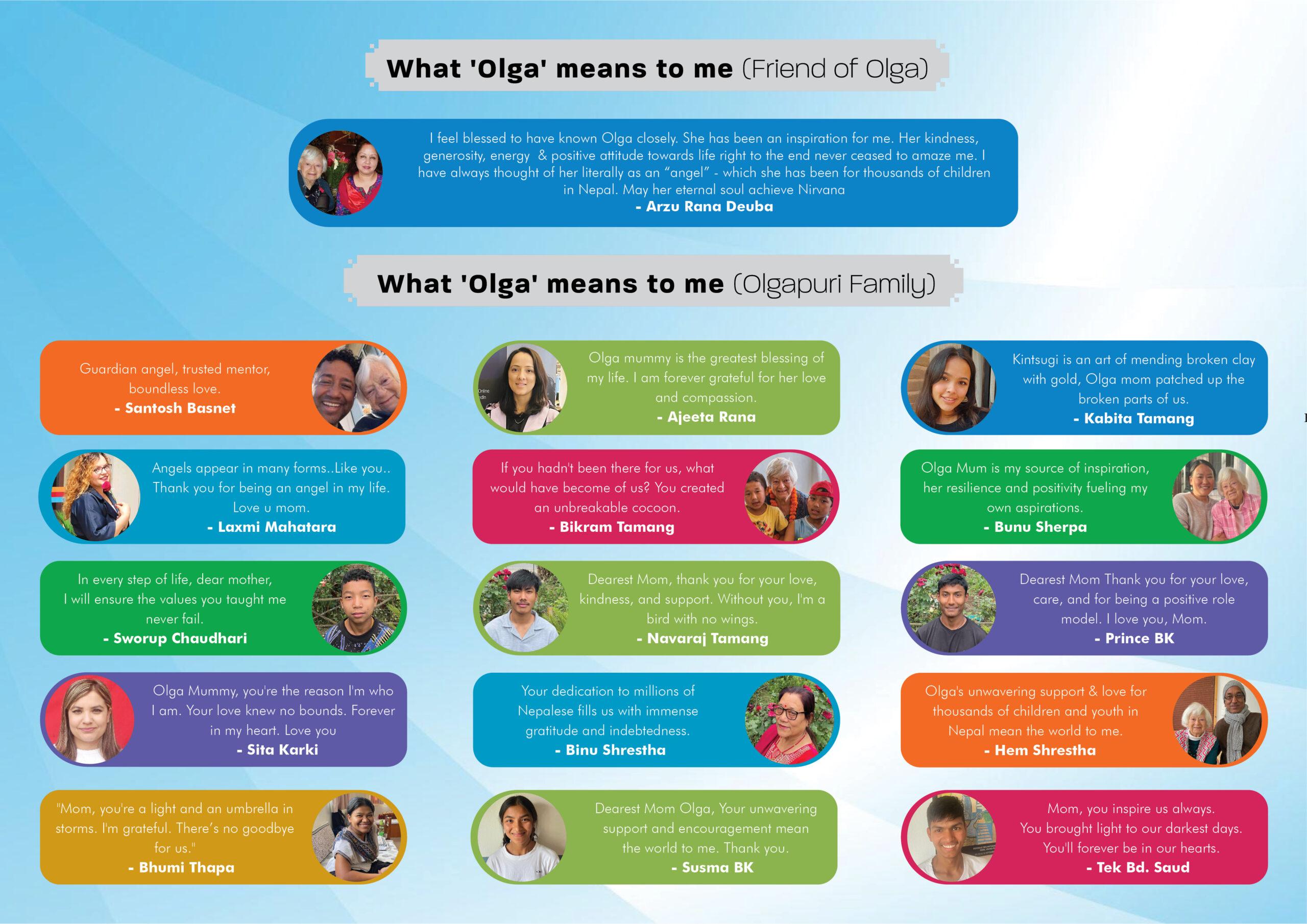
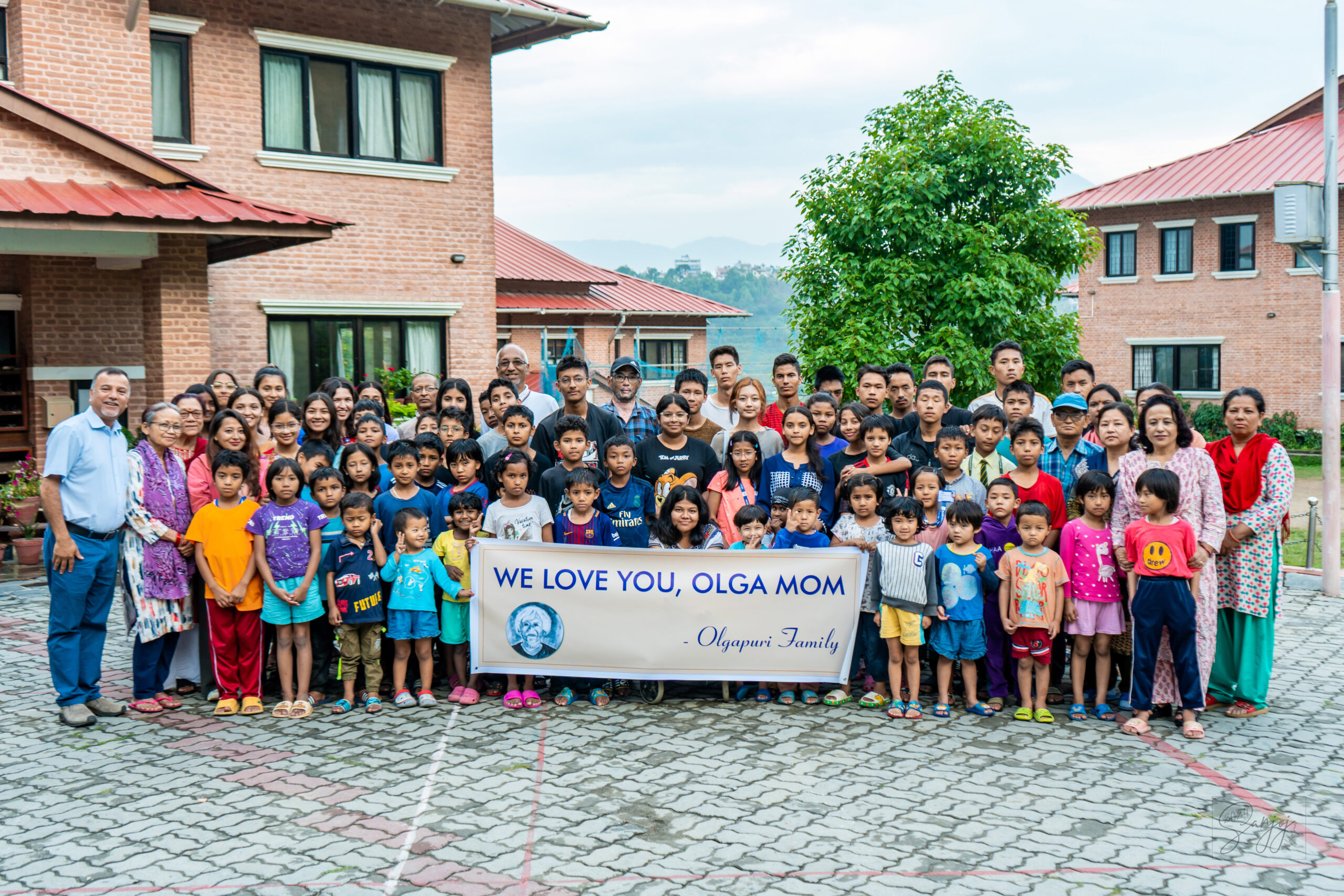
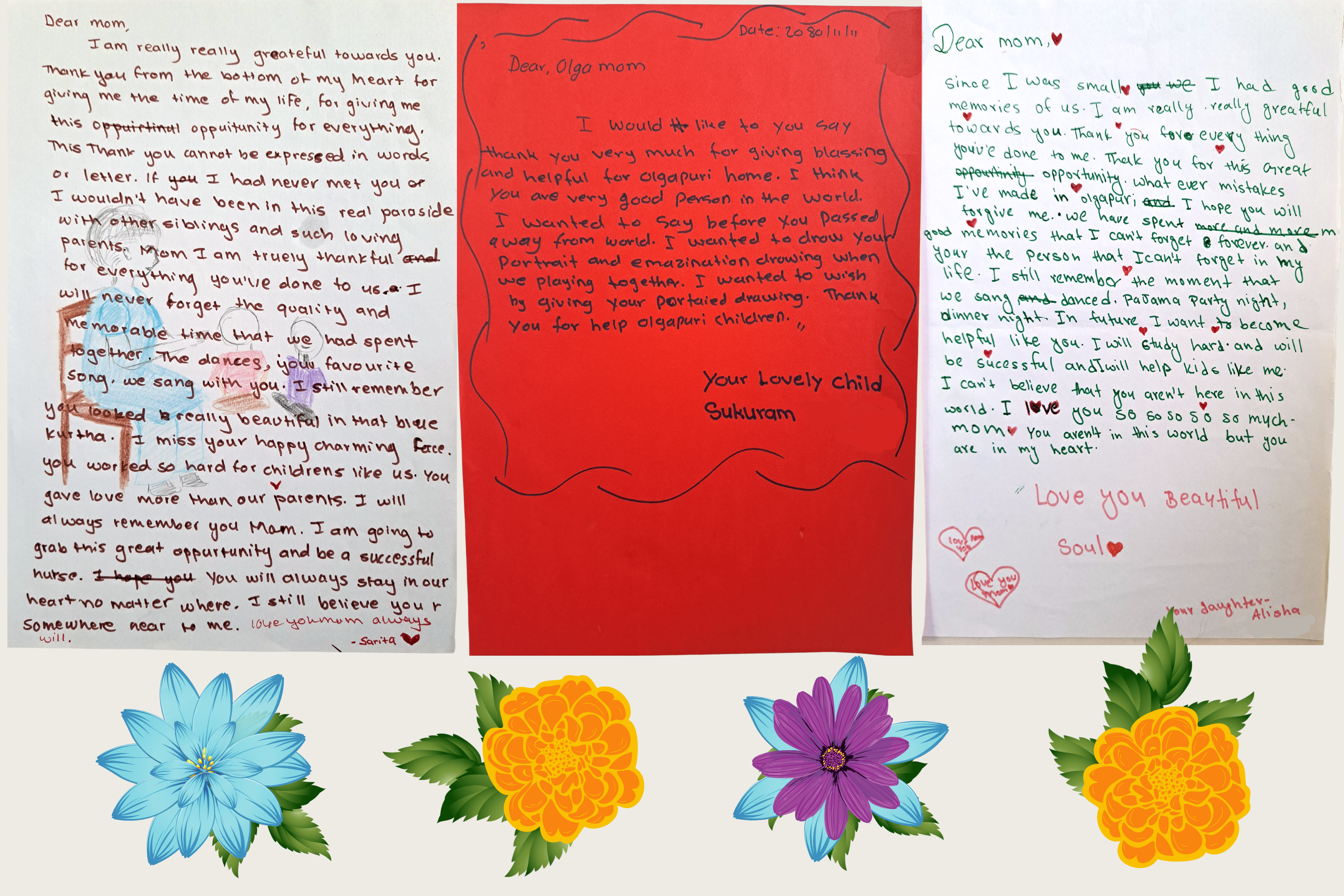
⮟
As visitors reached the end of the Tribute Room, they reached a small display of awards Olga received for her work in Nepal (generously lent to us by Olga’s family).
At the left appears Olga’s Order of the Gorkha Dakshina Bahu, third class, which was presented to Olga by the King of Nepal in the early 2000s, before the kingdom was abolished to make way for a democracy. Though the award no longer exists, it was an order of knighthood in Nepal—the second highest in the Kingdom of Nepal, presented for distinguished contributions to the country.
The next medal was awarded to Olga by the World of Children, and the final medal was presented by the Conrad Hilton Foundation, each in recognition of Olga’s work to liberate and empower Tharu girls from kamlari bondage.
At back, filled with paper flowers, is a hand-woven basket presented by a woman in Saptari District during Olga’s final visit to Nepal. Olga promised this woman that she would cherish the basket for the remainder of her life—a promise she kept.
Several more passports were also included.
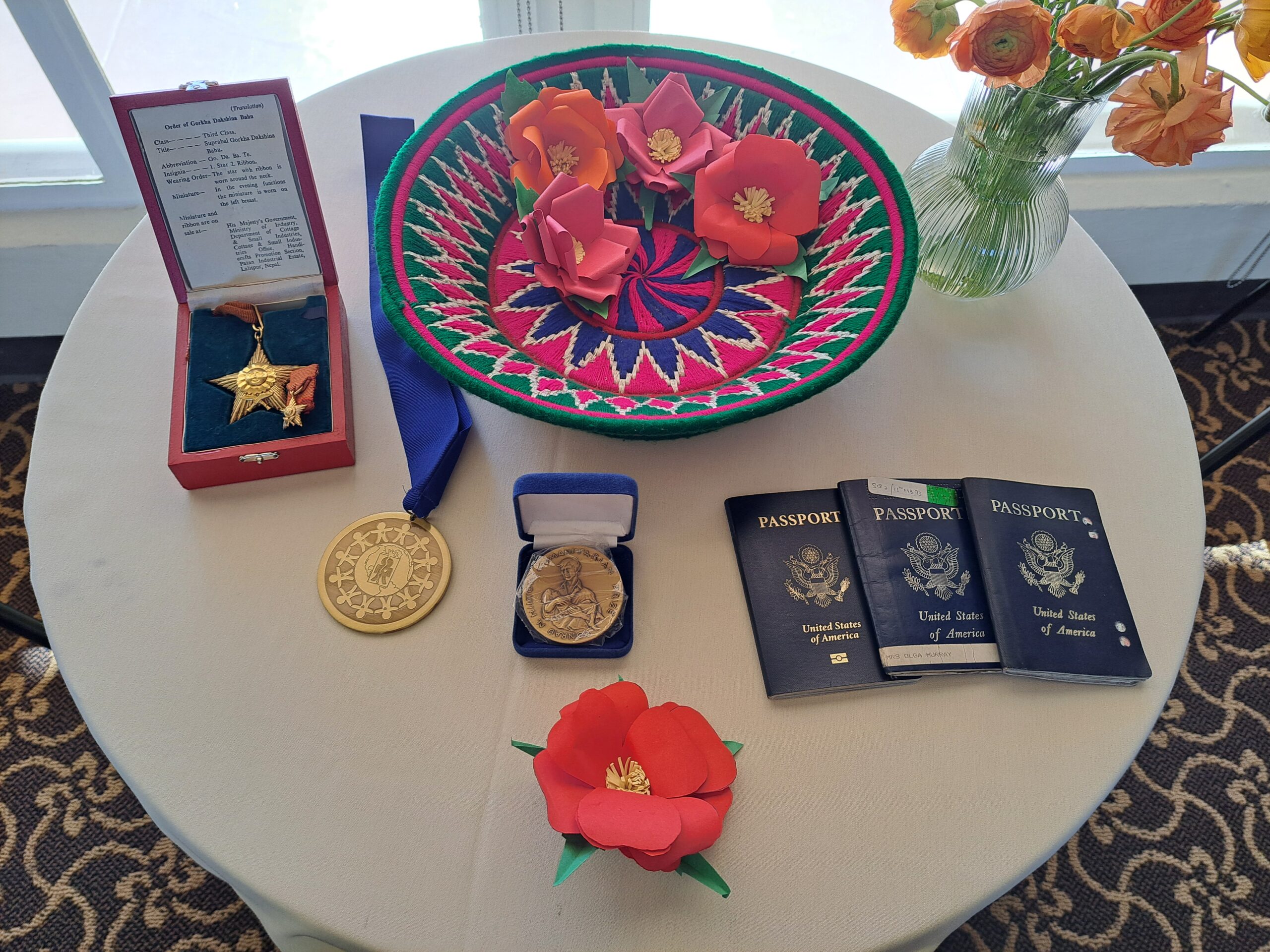
⮟
CEP – Wanting it to Continue
During her final visit to Nepal in 2022-2023, Olga visited the Saptari District villages where the Caste Equality Project was set to begin. There, she made sincere promises to the community—promises she was confident the NYF Community would keep long after she was gone.
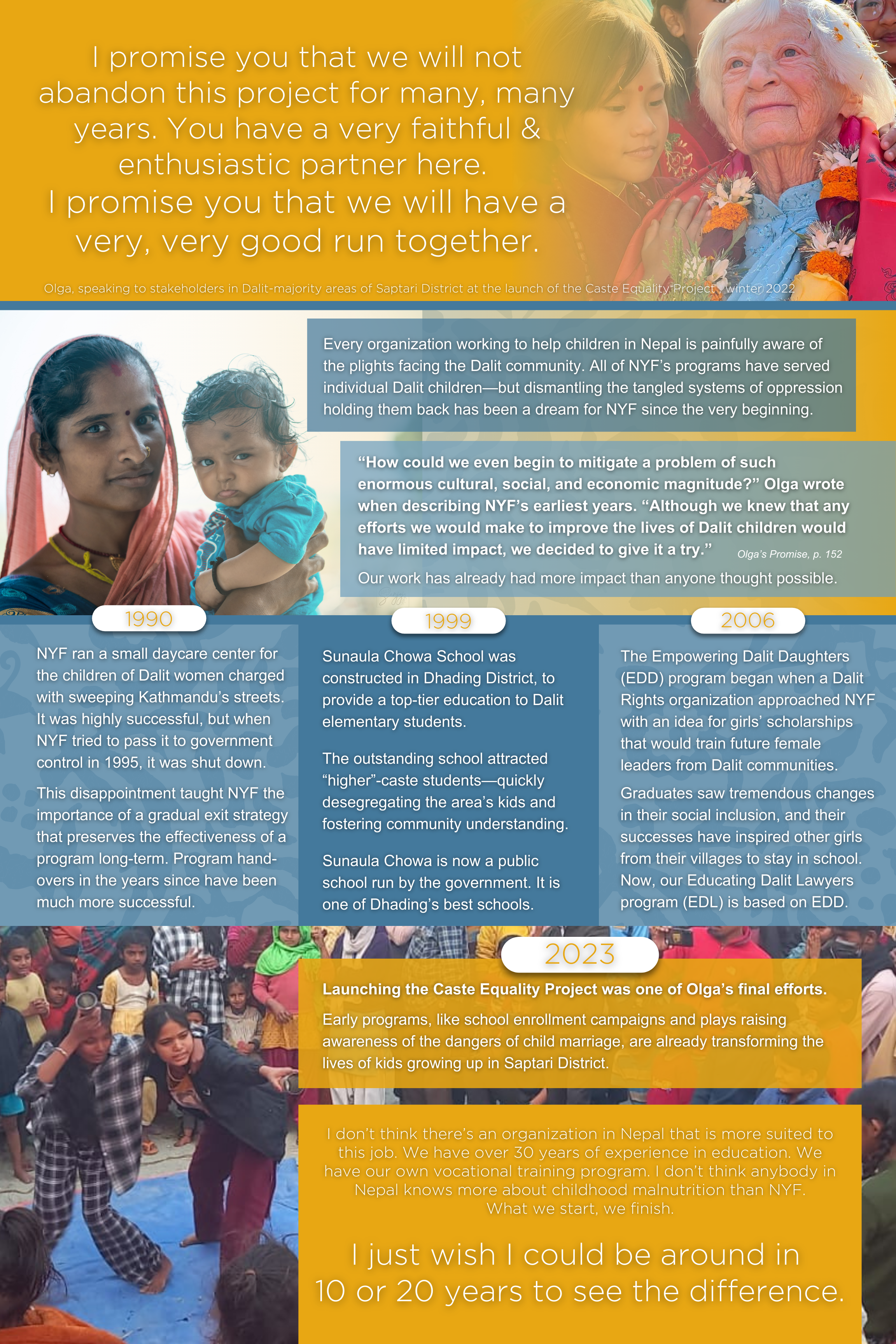
⮟

Olga’s transformative impact on the children of Nepal had roots stretching back to her earliest experiences as a tiny child immigrating to the United States aboard a steamship.
We are in awe of Olga Murray’s remarkable legacy and honored to be entrusted with the remarkable task of carrying her work forward in the lives of thousands of Nepal’s children.
A core resource when preparing this Tribute Room was Olga’s autobiography, Olga’s Promise—but in so little space, we were barely able to scratch the surface. If you would like a free copy of this inspirational book, please email us at info@nepalyouthfoundation.org.